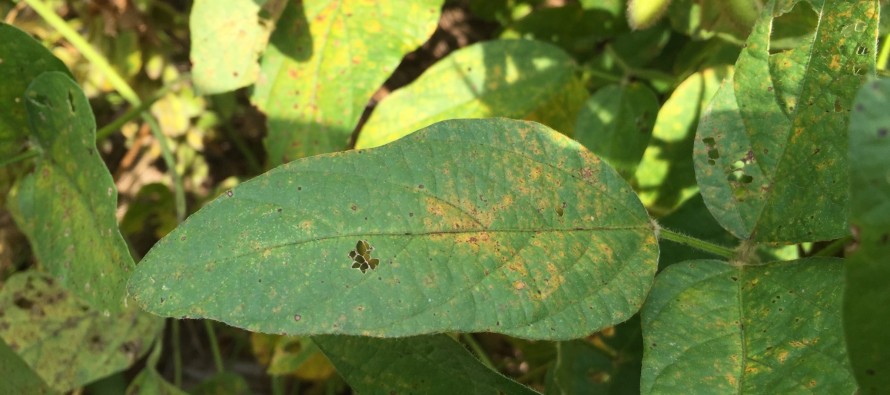UPDATED First Soybean Rust of 2016 Detected in Four Southwest MS Counties

Related Articles
- 2010 Soybean And Corn Variety Trial Data 3
- Rice Variety Trial Results For 2010, Plus Rice Research Report 0
- Evaluation of Peanut Prescription Rx Program in Mississippi 0
Latest Tweets
Soybean rust was detected in kudzu patches in Amite, Pike, Walthall, and Wilkinson counties on Tuesday (5/24) and Wednesday (5/25) afternoons. In the 12 years since the first observation of soybean rust in MS, this is the first time soybean rust has been detected in May within the state. In fact, based on previous experiences with the disease this is the earliest soybean rust detected in MS by a little more than 6 weeks. Kudzu is an additional host for the disease and the closest soybean relative growing in MS. Estimates suggest we have approximately 500,000 acres of kudzu growing in 81 of the 82 counties in MS. However, not all kudzu is susceptible to the disease and approximately 10% of the kudzu in the state is likely resistant or immune to soybean rust, which makes scouting for the disease a difficult endeavor. Since 2004 we have recognized a tremendous number of susceptible kudzu locations which aids in the detection of the disease.
Outside of MS, soybean rust has been detected on vegetative and reproductive, volunteer soybean plants in Louisiana. However, at present soybean rust has not been observed on the 2016 soybean crop. Active soybean rust has been detected in AL (3 counties), FL (13 counties all on kudzu), GA (1 county on kudzu), LA (11 total parishes, most on kudzu and some on volunteer soybean plants from the 2015 season), and MS (3 counties on kudzu).
Given the history of the disease in the U.S., it is likely that if temperatures continue to increase and rainfall remains scarce that soybean rust will NOT be an issue even having been detected in the state earlier than “normal”. In general, the fungus that causes soybean rust does not like temperatures above 92F. In addition, in years when a dry environment prevails the disease has difficulty getting started and is generally not a threat to soybean production. Since the initial estimates of the disease causing large yield losses, that were made in 2004 and 2005, the disease has resulted in minimal yield losses in parts of MS. During 2009, one of the wettest years in recent memory, some farmers in a few isolated cases observed substantial yield losses in Noxubee County. However, in general the yield losses observed that year were rare.
Fungicides are beneficial at reducing the disease; however, making a fungicide application to a vegetative soybean plant would not be beneficial. Residual fungicide efficacy typically lasts 17 to 21 days, depending on product chemistry as well as fungicide rate applied. Therefore, a single fungicide application made at vegetative growth stages will not last the entire season regardless of what someone tells you about a specific fungicide product. Given the current economic climate and outlook for the 2016 season we would suggest you save your money at this time.
The most important thing to know at this time is that the disease has been detected in the state and we continue to scout to determine the geographic distribution within MS. In addition, sentinel plots have been established throughout the state as a result of funding from the Mississippi Soybean Promotion Board and the United Soybean Board’s continued support of the disease monitoring program in the southern U.S. It is possible we will find more soybean rust this week or we may not find any more soybean rust until August. Environment dictates the disease progression over time. Stay tuned to the Mississippi Crop Situation blog as well as up-to-date information available at: http://sbr.ipmpipe.org/cgi-bin/sbr/public.cgi
Be mindful that scouting for soybean rust early in the season is extremely difficult as numerous foliar diseases as well as herbicide and insect injury can mimic symptoms of the disease on both the upper and lower leaf surfaces. Feel free to call should you have specific concerns regarding the disease or need additional information specific to your farm’s location.





Let me tell You a sad story ! There are no comments yet, but You can be first one to comment this article.
Write a comment